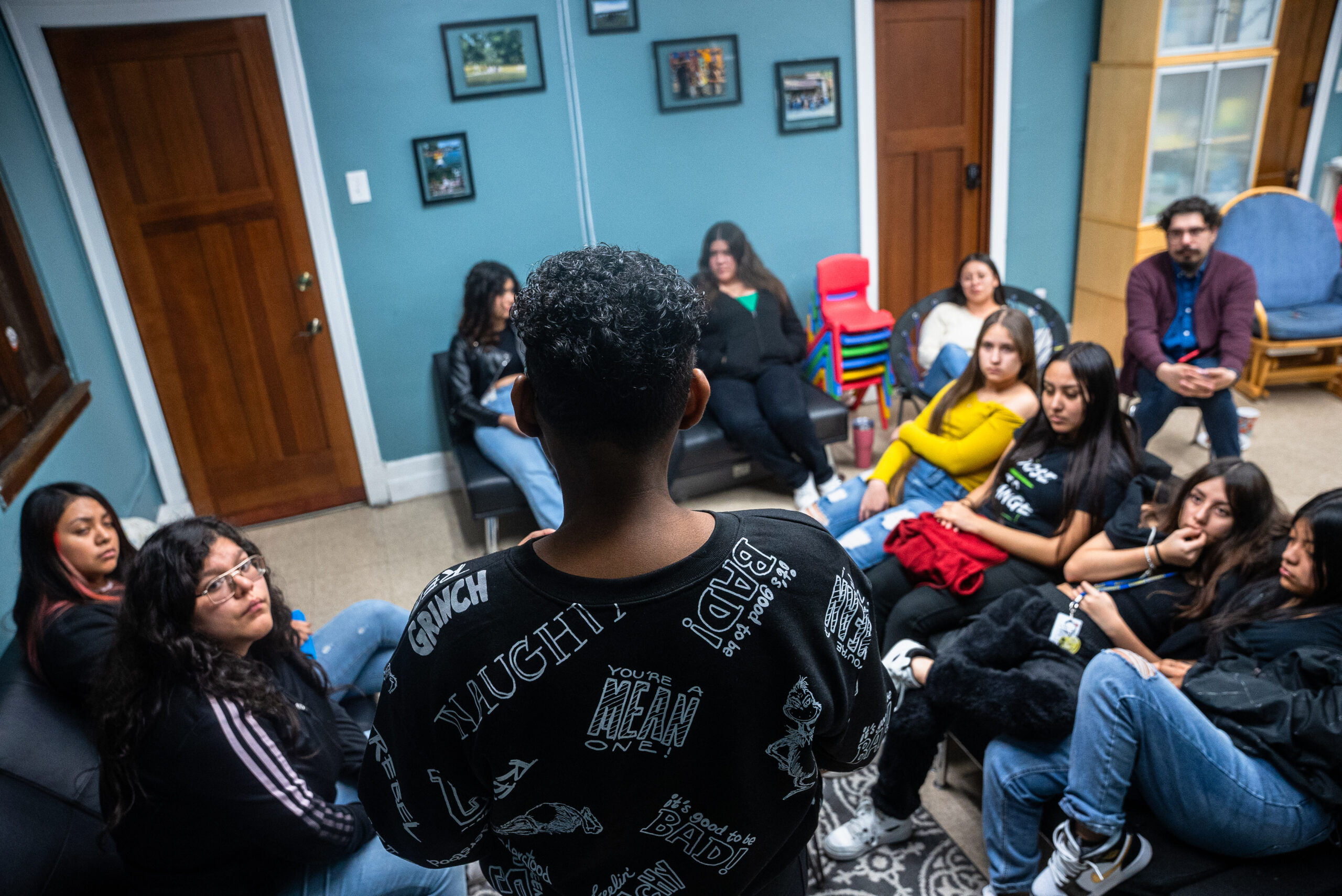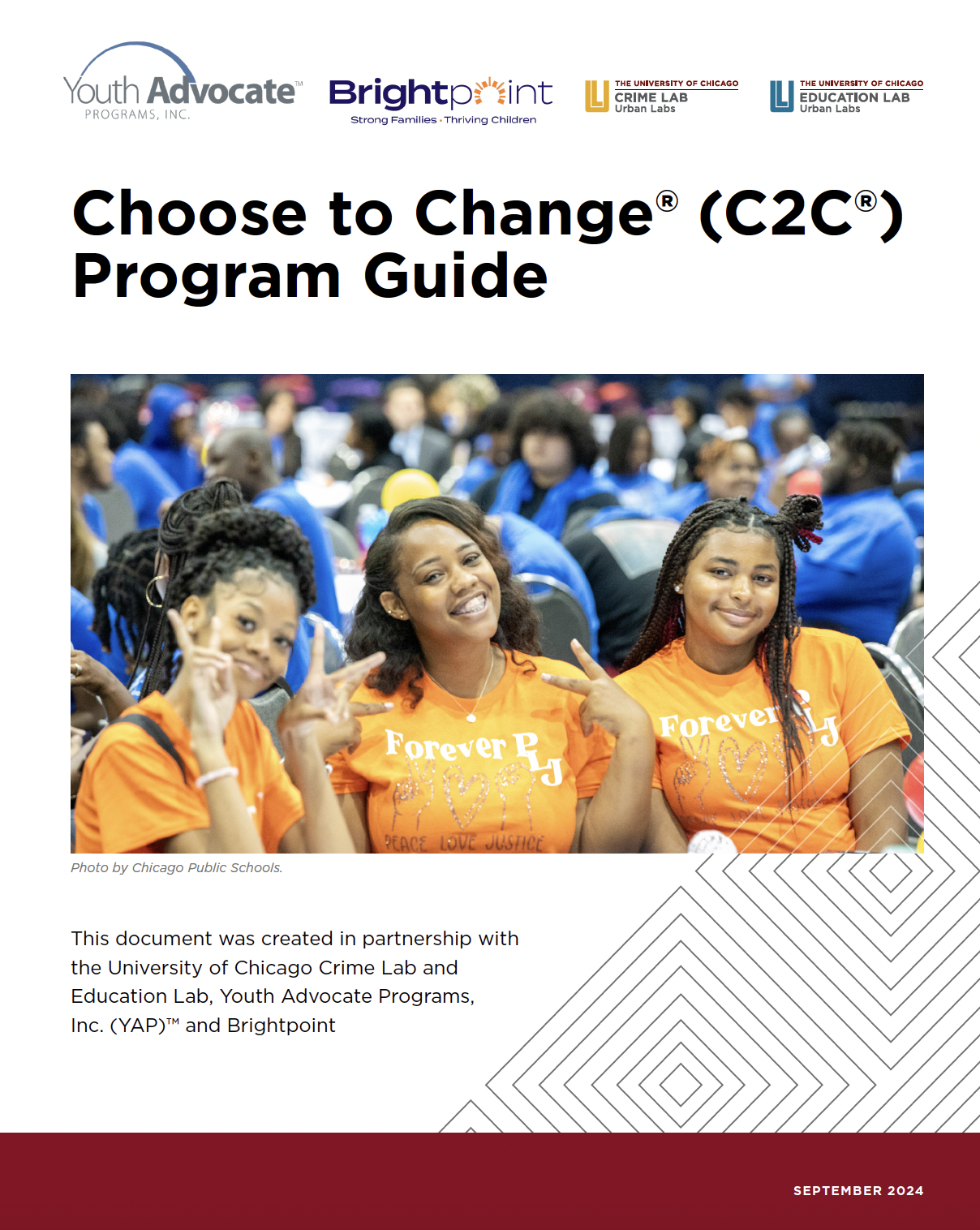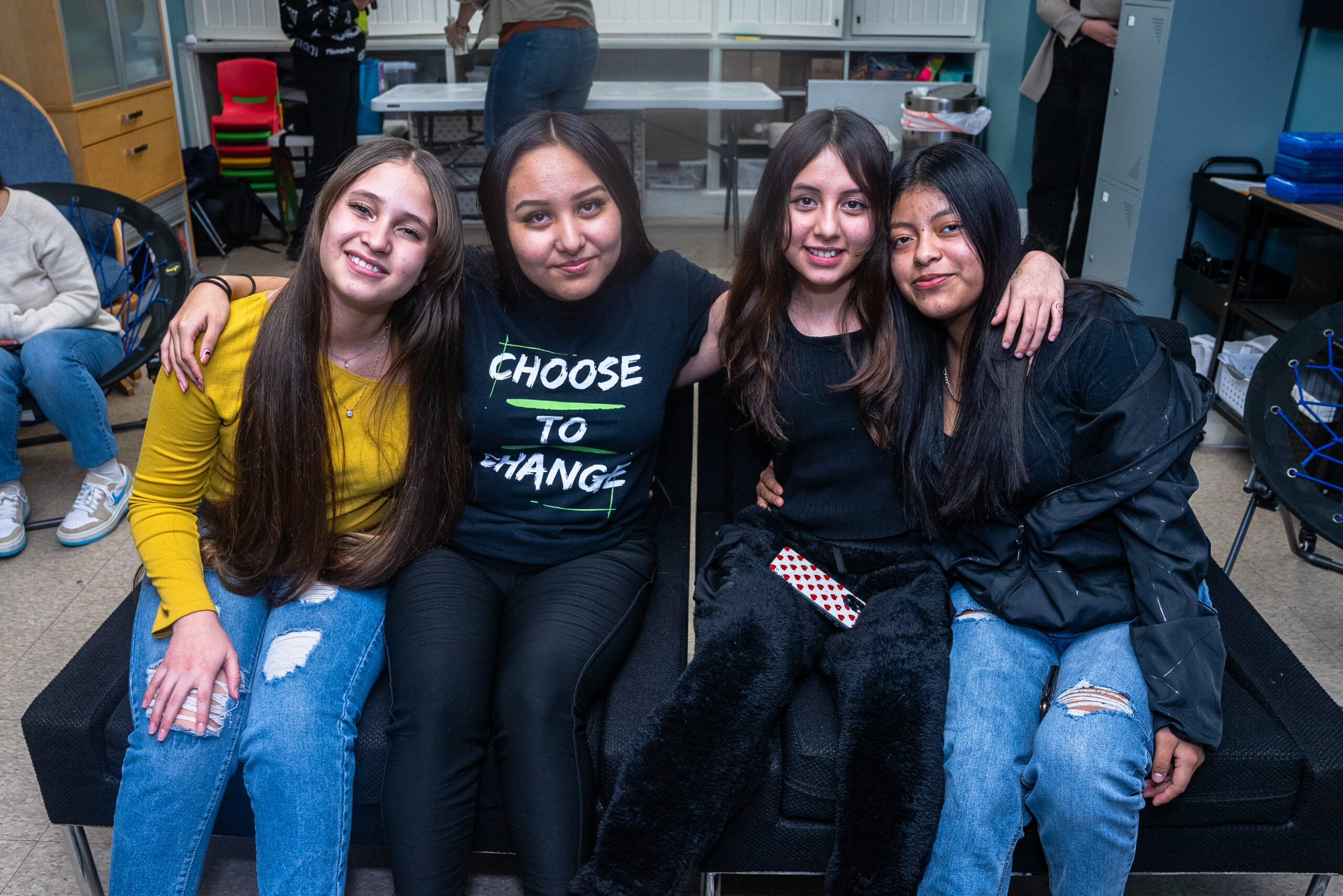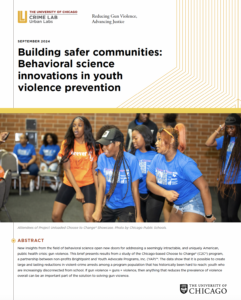Choose to Change®


Building safer communities: Behavioral science innovations in youth violence prevention
Released October 3rd, 2024: Results from a study of Choose to Change® (C2C®), a partnership between nonprofits Brightpoint and Youth Advocate Programs, Inc. (YAP)™ with support from Chicago Public Schools (CPS), demonstrates that it is possible to create large and lasting reductions in gun violence and imprisonment among a population that has historically been hard to reach: youth who are increasingly disconnected from school.
The Choose to Change® (C2C®) program combines trauma-informed therapy with wraparound supports and aims to reduce youth violence while improving educational outcomes outside of an institutional setting.
Challenge
Gun violence disproportionately affects youth and young adults in Chicago’s historically under-resourced neighborhoods. Frequent exposure to violence and trauma can impact youth’s mental health, emotional development, and academic engagement. Ensuring young people in Chicago have access to effective support services such as cognitive behavioral therapy (CBT) can be challenging when youth are disengaging from the same institutions likely to provide these supports, such as schools.
Opportunity
C2C® seeks to connect with an underserved population of youth who may be facing considerable challenges, including school truancy or prior criminal justice engagement, and provide a comprehensive set of supports outside of school that seeks to address barriers and meet basic needs while also building social-emotional skills. Developed by Brightpoint (formerly Children’s Home & Aid) and Youth Advocate Programs, Inc. (YAP)™ in 2015, C2C® provides trauma-informed cognitive behavioral therapy (CBT) and intensive mentoring to youth in Chicago’s south and west sides. The Crime Lab and the Education Lab conducted a large-scale randomized controlled trial of C2C® to determine if C2C® can effectively reduce violence and criminal justice involvement overall and increase education engagement.
Solution
The study finds that C2C® can effectively and sustainably reduce violence engagement and the likelihood of being arrested. Two years after the program, C2C® reduces the likelihood of youth being arrested for a violent crime by 39 percent. The positive effects of C2C® extend for at least 36 months after randomization, and participants were 23 percent less likely to face arrest during this period.
Project overview
In response to a 2015 design competition, as part of an initiative launched by the University of Chicago Crime Lab and Education Lab to crowdsource youth violence prevention interventions from across the city, Brightpoint (formerly Children’s Home & Aid) and Youth Advocate Programs, Inc. (YAP)™ jointly created C2C®: Your Mind, Your Game. C2C® is a six-month intervention offering youth intensive wraparound and mentoring services that focus on addressing each young person’s specific needs, along with trauma-informed CBT that helps youth process previous trauma and develop a new set of decision-making tools.
Youth in the C2C® program receive intensive mentoring from advocates from YAP. Advocates are professionally trained mentors who come from backgrounds and communities similar to those of the youth they mentor. This allows them to develop strong personal relationships, which are crucial for engaging youth in all aspects of the program. In addition to the mentoring relationship, Advocates provide wraparound support for youth and their families/caregivers in the participants’ homes and communities. This includes a broad spectrum of services, from helping youth obtain basic necessities such as food and housing to motivation and direction on larger goals, such as employment and college. On average, Advocates dedicate eight hours a week to supporting a young person.
After youth receive about a month of wraparound supports, the mentor brings the youth to weekly group trauma-informed CBT sessions facilitated by clinically trained therapists from Brightpoint. The CBT sessions draw from the SPARCS (Structured Psychotherapy for Adolescents Responding to Chronic Stress) curriculum, which help youth regulate their emotions and understand how past traumatic experiences or chronic stress can impact their thinking and behavior. Through exercises and conversation, youth learn to challenge unhelpful thinking, develop more resilient coping mechanisms to address stressors and build problem-solving and communication skills.
Outside of group sessions, mentors spend time doing fun social activities with the youth, experiencing new parts of the city, and modeling the skills and tools the youth learn in the CBT sessions. This allows for “learning by doing” and creates opportunities for youth to develop new habits that will benefit them after the program ends.
Years Active
2015 – present
Topics
Project Leads
Nour Abdul-Razzak
Research Director, Inclusive Economy Lab

Monica Bhatt
Senior Research Director

Heather Bland
Research Manager

Brandon Domash
Analytics Manager

Kelly Hallberg
Scientific Director, Inclusive Economy Lab; Senior Research Associate, Harris School of Public Policy

Cristobal Pinto Poehls
Analytics Manager

Kim Smith
Director of National Programs and External Engagement


Choose to Change® (C2C®) Program Guide
This program guide is intended for community-based organizations working to fill gaps in services and reach an underserved population of youth impacted by violence and trauma.

Choose to Change® provides some of our most vulnerable youth with the human connection and skills that can build their cognitive reserve and change the trajectory of their lives. We are focused on integrating social-emotional lessons into the daily student learning experience within CPS and are grateful for this programming that gives youth extra support and the second chance that everyone deserves.
CEO of Chicago Public Schools

These results indicate we have found a sustained way to interrupt the cycles of violence and trauma that our young people experience. This research shows that youth are making safer and healthier choices for themselves and are part of making their own communities safer and healthier while in C2C® and for years after participating.
President & CEO at Brightpoint

The Crime Lab’s findings reinforce what we already know: C2C® works. The study provides evidence that blending cognitive behavioral therapy and intensive mentoring and individual and family support is an effective model for supporting young people and producing life-changing outcomes.
CEO at YAP

Brightpoint and YAP are exemplars in the nonprofit sector for their commitment to generating the highest standard of evidence. With this research, they are supporting the entire field with data about how we can best help young people harmed by the twin challenges of gun violence and justice system involvement. This evidence adds to the mounting body of evidence that even well into adolescence and young adulthood, it is not too late to ensure young people avoid violence and justice system involvement. But we need to follow the data if we actually want young people to thrive.
Crime Lab and Education Lab Founding Executive Director
The Research Study
In 2015, researchers at the Crime Lab partnered with YAP and Brightpoint to design and implement a large-scale randomized controlled trial (RCT) of the C2C® program to evaluate the program’s impact on criminal justice engagement and academic outcomes. Between 2015 and 2019, 2,074 eligible youth were identified for the program and were referred from community service providers and schools from the south and west neighborhoods of Chicago. Youth who are actively affiliated with a gang or at risk of engaging, on juvenile probation, previously found guilty of weapons offenses, disruptive in school through chronic truancy, serious misconduct and/or frequent suspension, or the direct victim or witness to traumatic violence are eligible for C2C®.
There were not enough program spots for all candidates to be served, so a lottery was used to determine who was offered C2C® versus services that are normally available. Since the only difference, on average, between the youth with and without a C2C® offer is the C2C® offer, comparing the outcomes of youth in both groups isolates the impact of C2C®.
Who C2C® Serves
C2C® was able to successfully engage youth facing many intersecting challenges, such as prior criminal justice involvement and school truancy. Youth in the study were, on average, almost 16 years old and in the first few years of high school. About 95 percent of the youth in the study are Black and almost all youth qualify for free or reduced lunch. A significant percentage had been previously arrested (35%), and 20 percent had a gap in enrollment at some point during the prior school year. Compared to the broader Chicago Public Schools (CPS) population, C2C® youth are much more likely to be previously victimized and previously arrested.
C2C® participants stay engaged. Despite facing many barriers to participating, 62 percent of youth offered C2C® participated in programming (defined as attending at least one therapy session and/or five hours of mentoring). Conditional on being a C2C® participant, C2C® youth attended, on average, nine CBT sessions and received about 176 hours of wraparound services over the course of the program. This high level of engagement is especially notable given many of the young people in the study had only a tenuous connection with school when they were recruited for participation.

Untapped Levers for Reducing Gun Violence: The Impact of Behavioral Science Programs
The Crime Lab hosted a webinar on Thursday, October 10th that explored our latest findings on behavioral science interventions and their effectiveness in reducing gun violence.
Summary of Research Findings
To understand how the program impacts contact with the criminal justice system, we use administrative Chicago Police Department arrest data.
C2C® participants were substantially less likely to be arrested in the 24 months after randomization. We find that engaging in C2C® resulted in a 31 percent reduction in the probability of any arrest in the 24 months after randomization, a statistically significant decrease. Three years after randomization, we find sustained impact with C2C® reducing the likelihood of any arrest by 23 percent. We find that C2C® leads to no significant reductions in the number of arrests post-randomization.
Breaking these arrests down by the charges associated with them, we find large reductions in violent offense arrests. During the course of programming (6 months), C2C® reduces both the number of violent arrests and the likelihood of arrest for a violent offense by 47 percent. We see similar persistence in impact: at 24 months post-randomization, C2C® reduces the likelihood of a youth being arrested for a violent offense by 39 percent. These impacts are statistically significant even after adjusting to reduce the risk of false positive results.
To better understand the impacts of C2C®, given an arrest is a proxy for criminal behavior, we create a supervised machine learning algorithm from arrest narratives that determines if an arrest was initiated more or less at the discretion of police. We find that the program’s impacts are concentrated in arrests where officers have less discretion in initiating contact, while having little impact on more discretionary contact arrests (e.g. a young person exhibiting “suspicious” behavior). This analysis suggests the effects of the program are being driven by a reduction in actual youth offending behavior rather than by avoiding police contact.
Looking Ahead
This study finds that C2C®, a youth behavioral health intervention in Chicago, can effectively engage harder-to-reach youth, substantially reduce violence involvement, and reduce the probability of arrest in the short and longer term. In the context of other successful CBT-based programs in Chicago, C2C® highlights the possibility of engaging a harder-to-reach population of youth outside of school without having to wait until someone reaches adulthood or is detained.
These results highlight the promise of behavioral health interventions in developing meaningful and sustained impacts for youth by providing them with tools to navigate challenging environments that are often plagued with a lack of safety and economic opportunity. The longer-term impacts of this program are especially promising as many youth programs see fade-out shortly after the program ends.
Future work on the C2C® research study will incorporate the impact of the program on youth education outcomes including impacts on graduation. The results of these efforts will continue to be disseminated on an ongoing basis.
This study received support from Arnold Ventures, the AbbVie Foundation, Arnold Ventures, Chicago Sports Alliance (comprised of the Chicago Bears, Chicago Blackhawks, Chicago Bulls, Chicago Cubs, and Chicago White Sox), Crown Family Philanthropies, National Institutes of Health, Get In Chicago, the John D. and Catherine T. MacArthur Foundation, National Science Foundation, Pritzker Pucker Family Foundation, and Robert R. McCormick Foundation.
Research reported in this publication was additionally supported by the Centers for Disease Control (CDC) National Center for Injury Prevention and Control under award number 1-R-01-CE002971 and by the National Institutes of Health under award number 5P01HD076816. Nour Abdul-Razzak gratefully acknowledges support from the National Science Foundation (NSF) Graduate Research Fellowship Program. The content is solely the responsibility of the authors and does not necessarily represent the official views of the CDC, the National Institutes of Health, NSF, other funders, data providers, or implementing agencies.
Project Partners
Brightpoint

Youth Advocate Programs, Inc.

Chicago Public Schools

Related News
In Chicago, cognitive behavioral therapy shows promise curbing youth violence
NPR’s Meg Anderson reported on Chicago’s Choose to Change (C2C), a program that combines trauma-informed therapy with wraparound supports and aims to reduce youth violence. The Crime Lab found that the program can effectively and sustainably reduce violence involvement and the likelihood of being arrested.

University of Chicago Crime Lab Study Finds Youth Program Reduces Violent Crime, Results Persist for Three Years
A study of Choose to Change® (C2C®), a partnership between nonprofits Brightpoint and Youth Advocate Programs, Inc., found that participants are 39 percent less likely to be arrested for a violent crime.

Research shows signs of success in program stopping youth violence
Fox 32 Chicago covers new research from the University of Chicago Crime Lab showing how behavioral science interventions can reduce gun violence.


Building safer communities: Behavioral science innovations in youth violence prevention
This policy brief highlights results from a large-scale randomized controlled trial that evaluated the impact of Choose to Change® (C2C®) on participants’ criminal justice involvement.

Unpacking the Impacts of a Youth Behavioral Health Intervention: Experimental Evidence from Chicago
This working paper details results from a study of Choose to Change® (C2C®), a trauma-informed cognitive behavioral therapy and intensive mentoring program developed by nonprofits Brightpoint and Youth Advocate Programs, Inc. (YAP).

Choose to Change® (C2C®) Program Guide
This program guide is intended for community-based organizations working to fill gaps in services and reach an underserved population of youth impacted by violence and trauma.

Choose to Change® Research Brief
Learn more about the Choose to Change evaluation in this research brief.
